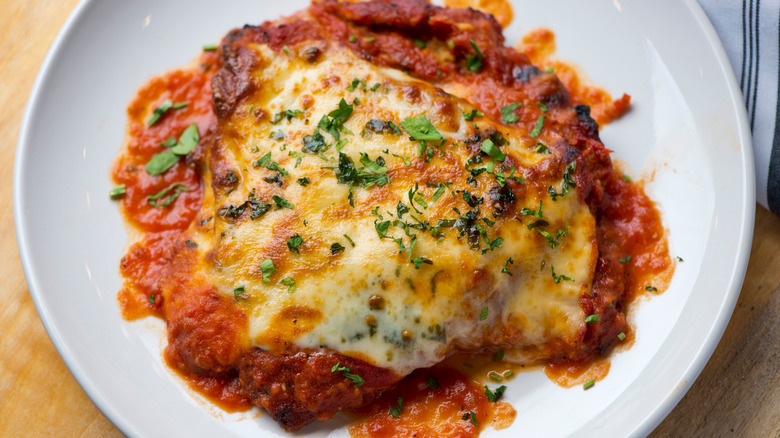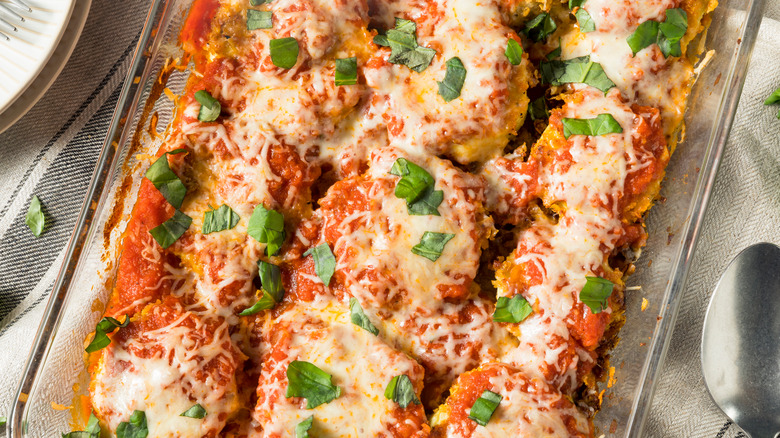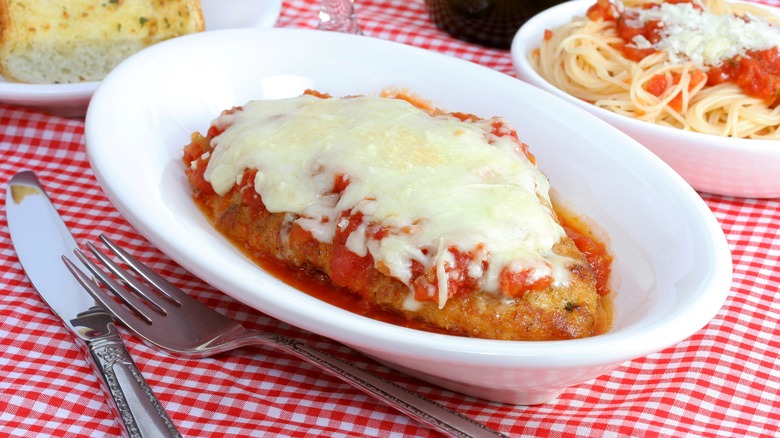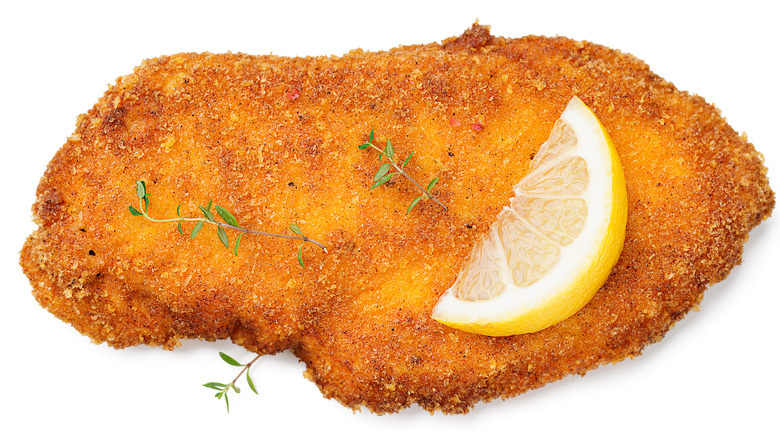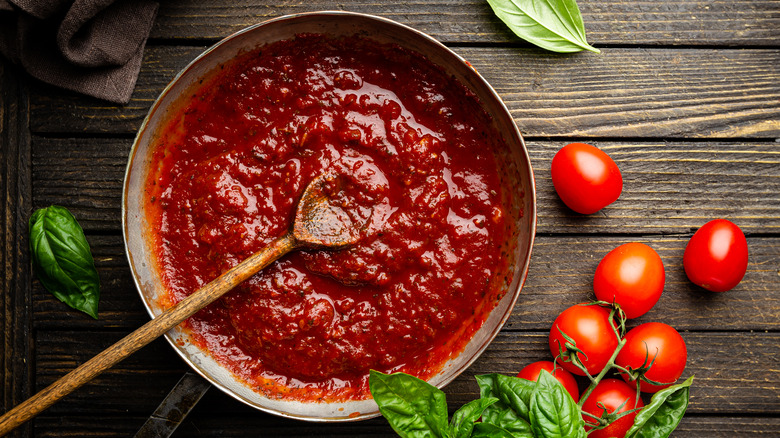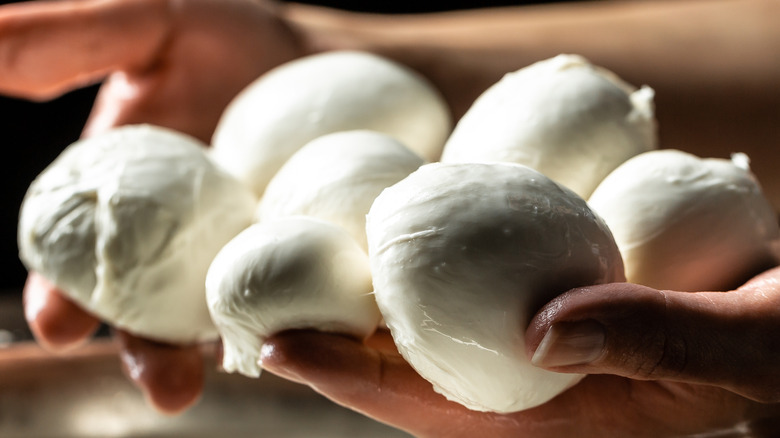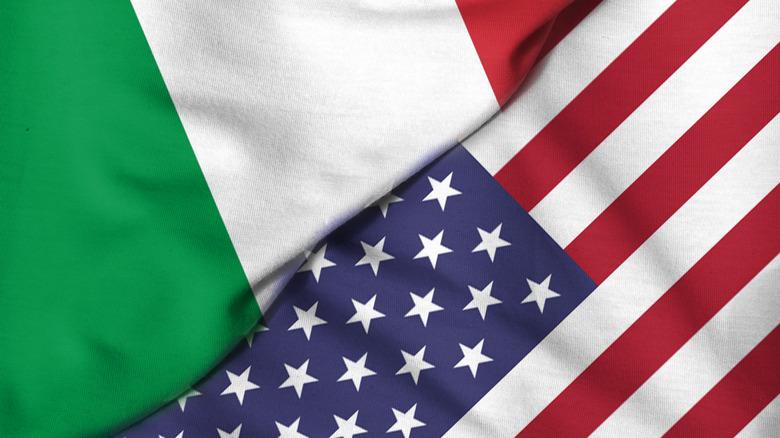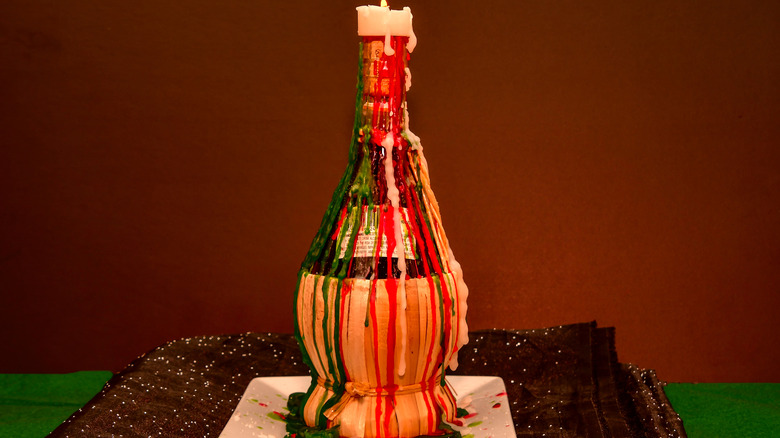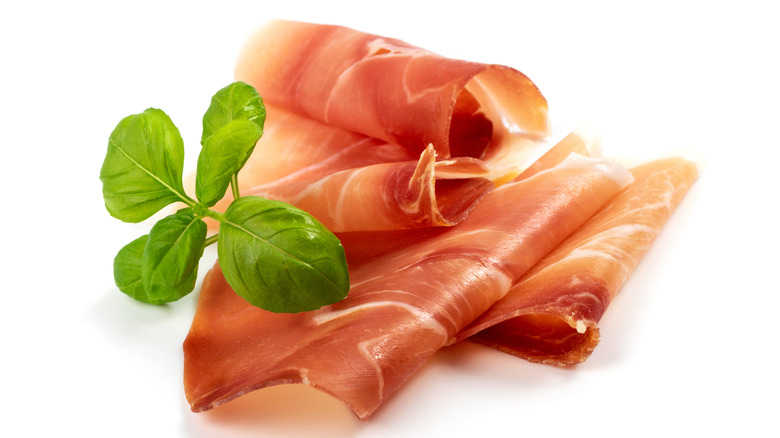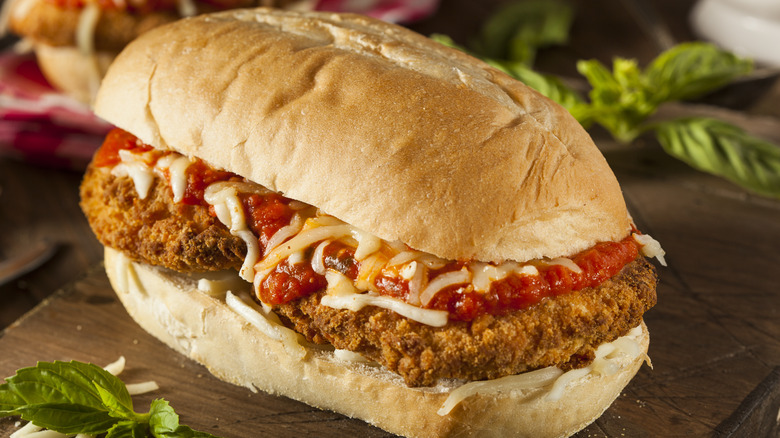The Untold Truth Of Chicken Parmesan
What could be more comforting than a plate of crisp chicken, savory tomato sauce, and melty-gooey cheese? Not much. It's stick-to-you-ribs food that manages to satisfy even when it's just an ordinary version from your local Italian take-out spot.
Although its origins are somewhat mysterious and it happens to be a late arrival to the world of Italian cuisine, it has remained a beloved staple in the US for decades. As eaters became more adventurous and Italian food started to gain the tremendous reputation it enjoys today, chicken parmesan has made its way into the hearts and stomachs of plenty of hungry eaters.
If the chicken doesn't stay crunchy and the mozzarella cheese stretches into strings as you take a bite, it's pretty hard to get mad as such a tasty combination of ingredients. The fact that it's available in just about any restaurant that claims to serve Italian food just means that there is ample opportunity to enjoy this spin on classic Mediterranean food.
Eggplant parmesan is the 'original'
In the US, most of the time Eggplant parmesan is thought of as just the vegetarian version of an Italian-American classic. However, it is actually the other way around — eggplant is the original version of this dish.
Called melanzane alla Parmigiana in Italian, this form of the dish originated in Southern Italy, where the poor soil made it difficult to raise animals for food but where enterprising — and thrifty — peasants could scratch out a living growing hardier crops like eggplant. It also thrived in the hot climate of the South.
Back in 1839, a dish that sounds awfully like what we think of as Eggplant parmesan is described in detail by the cook for a Southern Italian nobleman: fried eggplant is layered with cheese, tomato sauce, and basil and baked — pretty familiar stuff (per La Cucina Italiana).
Some even believe that the "Parmigiano" part of the name comes from a mistranslation of the word petronciana, which is an antiquated Persian word for eggplant. This seems like a stretch, but it's about as thorough of a hypothesis as you're likely to find.
Because it is also part of the typically poisonous nightshade family — which also includes bell peppers and potatoes — Europeans originally had the same aversion to eggplant that they did to the tomato. Once they got a taste of it, however, they never looked back.
The origins of the name are disputed
Chicken parmesan, or chicken parmigiana, appears to be named after cheese of the same name, made in the town of Parma in Italy. However, some experts have disputed this claim since the components of the dish — specifically the tomato sauce — are so atypical of the cuisine of Parma that another explanation had to be found.
One theory has it that the original name was "palmigiana," an Italian word for shutters. The logic is that the sliced eggplant in the original version resembled slats of window shutters.
Some experts, such as Sicilian food expert Pino Correnti, argue that the word is a corruption of "damigiana," which denotes a wicker basket for holding things like wine bottles or, in this case, the hot baking dish (per Paesana).
It's difficult to square the name with the contents of the dish, and despite Parmesan cheese being available outside of its home region of Parma since the 13th or 14th centuries (per History of Cheese), it does not appear in any of the classic recipes that have come down from the distant past.
If there is disagreement about why it's called what it is, there is at least the consensus that — whatever its origins — it is a satisfying and delicious combination.
It has Southern Italian roots but a name from the North
The name Parmesan signifies a dish from the town of Parma, a town in the Emiglia-Romagna region of Northern Italy (per Wandering Italy). This prosperous, fertile section of the country is one of the gourmet food centers of Europe and it produces what usually gets referred to as "the king of cheeses," Parmigiano-Reggiano.
Italy as a country is not very old — having only been unified in the mid 19th century — and the North and South are very different in terms of history, culture, development, and food. The North's food traditions revolve around the meat and dairy that come from the cows raised on the plains of the north. This climate also grows lots of soft wheat that get turned into delicate, fresh pasta.
In contrast, the poorer South has a rockier, hotter landscape where foods like tomatoes and eggplant thrive. Here, hardier durum wheat is grown to take advantage of the hotter, drier climate. This type of wheat is what dried pasta is made from and it constitutes a major difference between the North and the South.
In the United States, we tend to think of tomato sauce as quintessentially Italian. However, it's really more of a regional difference. The thick, cooked-down type of tomato sauce is characteristic of the South, hundreds of miles from the city of Parma.
The dish starts with a fried chicken cutlet, an Italian classic
Originally coming from the French word "cotelette," meaning something close to "riblet," a cutlet these days refers to a piece of meat that is pounded to a thin, even shape before coated in breadcrumbs and fried to crispy perfection.
There are lots of different traditions of cutlets all over the world, from the Japanese tonkatsu — a panko-crusted piece of pork served with shredded cabbage and a special sauce made of — surprisingly — ketchup, to the German approach known as schnitzel.
The classic Italian iteration called "alla milanese" comes from the city of Milan in the Northern province of Lombardy. Milan is the fashion capital of Italy and also one of the most developed and prosperous cities in Europe (per Britannica). It has a long tradition of refined food.
Typically, the process of making a cutlet involves multiple layers of coating. First, the meat is dipped in flour so that the surface is dry and subsequent layers can adhere. Next comes a beaten egg to act as glue. Finally comes the breadcrumbs, and once coated, the cutlet is fried in fat. This could be anything from neutral vegetable oil — flavorless and inexpensive — to the luxury of clarified butter.
The crisp end product can be served "as is," usually with a lemon slice on the side to squeeze over. It can also be dressed up in various ways, including being given the "Parmesan treatment."
It gets topped with a southern-Italian style tomato sauce
As strange as it is to imagine Italian food without tomato, it was not until the New World was "discovered" by Europeans that it was introduced to Italy. This blending is usually called the "Columbian Exchange" and it involves more than food, per Harvard.
Although tomatoes were originally considered poisonous in Europe, thanks to belonging to the deadly nightshade family (per Smithsonian Magazine), they took to the dry, warm climate of Southern Italy and soon became inseparably associated with Italian food.
The tomato originated in what is now Mexico, and the English word comes directly from the original Aztec term "xitomatl" (per Italy Heritage). However, Italians have a more romantic name for it — "pomodoro." It translates as "golden apple," and previously, they called it a love apple because it was widely thought to be an aphrodisiac.
There is a legend about an enterprising young man from the Southern city of Naples who sought to inflame the passions of a young woman by feeding her a sauce made from tomatoes. Shockingly, it didn't work, but he was so taken with the flavor and body of the sauce that he looked for other ways to utilize it.
A cooked, thick tomato sauce is emblematic of Southern Italian cuisine. While it may seem strange to have such a sauce attached to a dish named after the North, it's hard to argue with the delicious results.
It's typically baked with a topping of mozzarella cheese, despite the name
You would expect a recipe for something with the word "Parmesan" in its name to contain a ... certain cheese, but you would be wrong. The cheese most associated with this dish is mozzarella.
This creamy, soft, fresh cheese has traditionally been made from water buffalo milk, which is richer and creamier than the cows' milk most of us are used to. Although most of the mozzarella sold in the US is made from cows' milk, authentic "mozzarella di bufala" is imported for fancy cheese shops — at sometimes shocking prices. A form of cows' milk mozzarella does exist in Italy, and it is referred to by the poetic name "fior di latte" or "flower of milk."
One of the best parts of the cheese in a chicken parmesan recipe is when it is cooked in the oven and begins to take on color. This process of browning, called the Maillard reaction, creates entirely new flavor compounds that make for a much tastier end product than if it was simply melted.
A classic image of a finished dish of chicken parm is the cheese clinging to the fork and "pulling" into long strands. This is due to the unique process of making mozzarella. It receives a hot water bath that rearranges the structure of the cheese into long, stretchy strings that tend to cling together, even when it's melted (per Science Focus).
It's more of an Italian-American dish
Despite the fact that all of the component parts are authentically Italian, chicken parmesan has its origins in the US, according to Los Angeles Times. Similar to spaghetti and meatballs, this grouping of ingredients would be baffling to a native Italian.
In part, this comes from the fact that Italian immigrants — coming from the relatively impoverished South — found meat to be more widely available in their new country. Coming from Europe, which was a relatively stratified society where the right to raise animals as food was usually reserved for the upper classes (per NPR), newcomers to America were stunned to find that the huge, wide open spaces of their new country afforded them the opportunity to eat like kings. The same is true for immigrants to Argentina and New Zealand, two more countries with strong animal-raising traditions and lots of unused land (per Popular Science).
This adaptation of Old World sensibilities to New World circumstances is familiar to most immigrants, whether they come from Naples or Hanoi, according to Taste. As time goes on, this assimilation can achieve mainstream success. This has been proven by the beloved status of things like tacos, ramen, or even pizza — which, when first reported on by food writer Clementine Paddleford in 1939 was printed in italics to denote its foreign origin, according to the Italian Sons and Daughters of America. It's come a long way since, as explained by USA Today.
Chicken parmesan is a staple of 'red sauce joints'
There is a certain stereotypical image a lot of Americans have of what an Italian Restaurant looks like. There is a red and white checkered tablecloth and a melting candle in a Chianti fiasco — the iconic, straw-covered bottle — on each table, and the dishes rarely change from one location to the next.
These places are beloved by those who relish the familiarity and comfort, not to mention the garlic-scented air, according to Salon. In fact, this introduction of garlic to an initially fearful American public was largely accomplished through these family-friendly venues, where the food was not too foreign — just enough to feel adventurous. Meanwhile, even though we think of garlic and Italian food as synonymous, the reality is more complicated, per Taste. Many there view it as a vulgar or rustic flavoring, best reserved for the poor who can't afford more subtle seasonings.
True to the name, a lot of the food in these places is covered in a ubiquitous bright red tomato sauce. Usually referred to as marinara, this sauce manages to sneak its way into everything from the pasta to the seafood.
Chicken parmesan in these restaurants is just another canvas to be painted with this all-purpose sauce. It has essentially become a symbol of the kind of comforting, rib-sticking food you can get at your local red sauce joint, per The Food Table.
Some recipes include ham or bacon
Italy is a very old place, which has been inhabited for hundreds of thousands of years. The residents there have been able to hone their cooking down to the fine art of simplicity (per Table Agent). This means that many "recipes" are really just a group of ingredients that happen to taste particularly good together. Caprese salad is a case in point — its enduring popularity, despite being essentially just three simple ingredients, is proof that this formula of simplicity works.
Some people can't leave well enough alone and they like to add ham to chicken parmesan. Although it's more of an Australian custom, many recipes online specify adding a layer of ham underneath the cheese.
A good theory of why this became a trend is that the other food the town of Parma is known for is ham. To most Italians, this means prosciutto, which is not heated and merely cured with salt. This is the sort of thing that usually gets thinly sliced and wrapped around a slice of ripe melon, but it can be put to other uses, too.
This addition may be controversial to a purist, but there is no denying that including a slice or two of ham can bring some saltiness and extra chew to what is otherwise a very simple dish.
Cooks these days try to modernize it
Some cooks find it silly to take a crispy, fried cutlet and douse it in a wet sauce. The crisp texture is lost, obviating the entire reason for frying in the first place. It may have made sense when the eggplant version was the standard — eggplant doesn't really suffer when it's a little soggy — enthusiasts will call it "silky." It manages to soak up the flavor of the sauce particularly well, but these days, people are less likely to settle for a soggy plate of food.
Various fixes include using less sauce and making a barrier of cheese between the tomato and the crispy cutlet. Another popular adaptation is to include some actual Parmesan cheese in the breading. This adds a lot more flavor than the traditional breadcrumbs. Some creative cooks have completely reimagined the dish and will serve a deconstructed version — instead of all being cooked together in the oven, the components are kept separate and combined only on the finished plate.
Although this dish is traditionally served alongside a helping of pasta, enterprising cooks looking to lighten the effect of the dish will often serve it as a salad with the crispy chicken, cheese, and tomato all tossed with leafy greens. It's hard to improve on a classic, but it doesn't mean you can't try.
It often gets put into a sandwich
We like things big in America, and what could better express our love of large-format food than a sandwich that's a foot long? Depending on where you live, you may call it by different names: sub, hoagie, hero, po'boy, or grinder, but whatever you refer to it as, the format is an American classic.
Most people are familiar with an Italian sub, consisting of cold cuts, cheese, and oil and vinegar, but this original has been adapted into innumerable variations, which only need to be served on a long roll to be called a sub.
To make your own version of this sandwich, Serious Eats recommends using leftover chicken parm and making sure you thoroughly toast the roll in the oven after drizzling with olive oil. The oil will helps make a waterproof barrier that prevents sogginess.
These sandwiches are a mainstay at pizza places across the country, and even Burger King got in on the action. What tastes good as a stand-alone dish doesn't get any worse when served on some bread. Also, being able to eat with your hands is a definite plus for those on the go.
A recipe was first published in the New York Times in 1962
The "Newspaper of Record" threw its weight behind the legitimacy of chicken parm when it published a recipe back in 1962, per Mister Chicken Parm. The New York Times has been a major player in food journalism ever since the legendary Craig Claiborne took the helm of the Food section in the late 1950s.
His seriousness at covering food and dining meant that they could be taken seriously and were no longer relegated to so-called "ladies journals" and home economics classes. In post-WWII America, abundance meant that even middle-class families could afford to spend more time and money on what they ate.
Although Craig Claiborne was known for having somewhat snobbish tastes — he once wrote about a meal shared with one other guest that cost $4,000 at a Parisian restaurant — he was also dedicated to the idea that good food didn't have to be "fancy." He introduced his readers to the likes of Madhur Jaffrey and Marcella Hazan, embracing the Indian and rustic Italian cooking they loved.
The inclusion of chicken parmesan in the pages of the New York Times is a perfect example of the way Claiborne liked to mix "high and low." He introduced the dish to a wider public, and if the recipe is different than we're used to (it includes mushrooms and olives), the final product of cooked tomato, chicken, and cheese is all too familiar.
